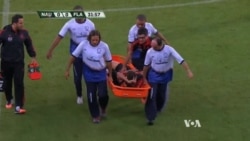Soccer is one of the most popular sports played by children in the United States. At the same time, research is under way to study head injuries such as concussions suffered by youths playing the game and the long-term effects of those injuries.
Soccer players take blows to the head through headers, as well as collisions with other players, the ground and goal posts.
Catherine McGill, a neuropsychologist for the Children’s National Health System in Washington, examines many children who have suffered concussions playing soccer. She said concussions sustained while playing soccer and other youth sports are on the rise for a number of reasons.
More concussions
“One, we are getting better — and I say 'we' meaning parents, coaches and medical providers alike — are getting better at recognizing and responding to that injury," McGill said. "That’s a huge testament to media paying more attention to this and leagues paying more attention to the safety of their players.
"Also, kids are getting bigger, faster, stronger across the sports, and so more injuries may be occurring simply because of that, and more kids are playing sports, and they’re playing more frequently.
"I used to have kids who played soccer for one season, and they played a different sport the next season," she added. "But now you've got multiple sports in multiple seasons, so it's just increased playing time, which is going to result in increased injuries, concussions included."
McGill participated this week in a panel discussion in Washington on efforts to make American-style football safer at the youth level.
Speaking to VOA later about soccer, she said researchers are looking into questions about soccer-related head injuries, including the impact from repeated headers and the degree of cognitive dysfunction a soccer player can suffer.
"We're often asked by parents, what’s the age, what age do they start heading, or should there be heading at all?" McGill said. "The answer is this is a very individual decision. The age for one child may be very different for the age of another child.
"You need to look at how strong is that child, how tall is their neck, how agile are they, and what is their level of skill development. You don't want to put someone on the field who hasn't developed in an automatic way the technique necessary to head the ball."
Long-term impact
According to McGill, researchers also are studying the possible long-term effects from soccer-related head injuries, including chronic traumatic encephalopathy, or CTE, a degenerative brain disease.
Two soccer players who suffered from CTE were Hilderado Luiz Bellini, who played on Brazil's World Cup-winning teams in 1958 and 1962, and Patrick Grange, an American semiprofessional player. Bellini died last year at age 83, and Grange died in 2012 at age 29.
Researchers also are trying to learn whether blows to the head from American-style football, boxing and other violent sports can lead to CTE.
“We don’t know if there are long-term effects from repeated head injuries," McGill said. "What we do know is that the vast majority of people do get better, and that there’s probably a minority who seem to take longer to get better and may have long-lasting consequences, and we need more research to fully understand that.
"There’s a lot of talk in the media about CTE and the relationship between that and repeated head injuries," she added. "Especially with kids in soccer, we just haven’t fully established that relationship, and we need more research so that we can make educated decisions.”





